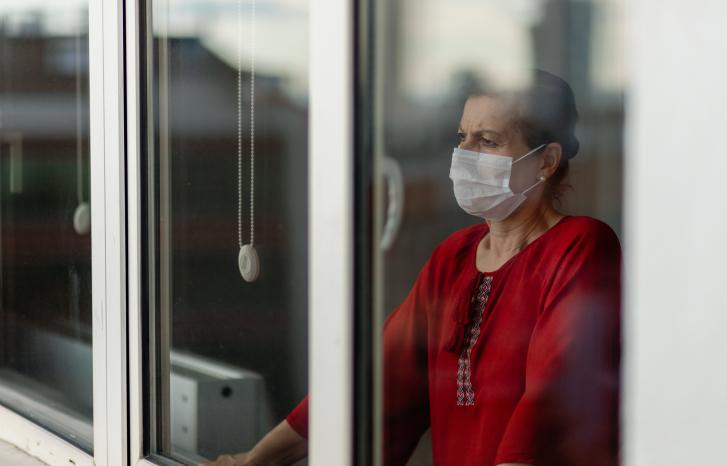“Sex specific recommendation could be an option that at least some countries could take into consideration,” says Sabine Oertelt-Prigione. She is a physician and researcher specialised in sex and gender medicine at Radboud University in the Netherlands.
She is referring to the serious cases of blood clots connected to the vaccination of covid-19 with the AstraZeneca and the Johnson & Johnson vaccines.
“In most countries, we are seeing a prevalence of thrombosis in women," says Oertelt-Prigione. However, she emphasises that the side effect is very rare among both sexes.
The European Medicines Agency (EMA) has confirmed that there is a connection between the vaccines and blood clot, and that approximately one out of 100,000 people vaccinated with the AstraZeneca vaccine experiences blood clot.
As likely as being hit by lightning
Norway paused the use of the AstraZeneca vaccine on March 11th. The decision was made following reports about serious cases of illness and death. Other countries have put age restrictions on who gets the vaccine.
“I was surprised that we did not see regulatory authorities consider sex disaggregated vaccine recommendations,” says Oertelt-Prigione.

She points out that men also risk getting thrombosis, although most of the people who have experienced the serious side effect are women under the age of sixty.
“We should consider that given the current numbers, the risk of this side effect is about the same as the likelihood of getting struck by lightning.”
Nevertheless, she maintains that one could have considered looking at the men and women who have experienced the side effect and set different age restrictions according to gender when using the vaccine.
“Differing between the sexes may not be the best solution, but at least we could have had a debate about whether this makes sense or not,” says Oertelt-Prigione.
Norway might choose differently
According to Oertelt-Prigione, this is particularly relevant in countries struggling with high infection rates and complicated contact tracing. Vaccines are among the most important solutions we have, she emphasises.
“Right now, all strategies are based on a good and effective rollout of vaccines. So it is not ideal to stop using certain vaccines.”
According to the researcher, we need to make a risk assessment and measure the benefits of using vaccines against the risk of thrombosis. For Norway, she believes that the risk might be greater than the benefits.
Read: “Pandemics affect women and men differently”
“For a country in a low risk situation, where you can easily contain cases, it is completely different than for a country that has a wide spread of the virus. Those countries need to do anything possible to contain the spread,” says Oertelt-Prigione.
In countries with high populations and higher risk of infection, they need to make different assessments, according to the researcher. She also emphasises that the covid-19 virus itself involves a twenty per cent risk of blood clot, although this is not the same, serious type as the one connected to the vaccines.
“Given Norway’s situation right now, I would not have prioritised the AstraZeneca vaccine at this point.”
“Need to be careful with the numbers”
Steinar Madsen in the Norwegian Medicines Agency emphasises that not only women have been affected by blood clot.
“The numbers are not certain, and in some countries, many more women than men have been vaccinated. Therefore, we need to be careful with these numbers, but there seems to be an overweight of women who experience this side effect,” says Madsen.
Given Norway’s situation right now, I would not have prioritised the AstraZeneca vaccine.
“Has Norway considered whether to continue offering the AstraZeneca vaccine based on gender or age?”
“Every option has been considered. When working with this, you are getting all sorts of thoughts about how we may continue to use this vaccine,” says Madsen. He emphasises that several countries have continued to offer the vaccine to people above a certain age.

Madsen agrees with Oertelt-Prigione that Norway is in a better situation than many other countries, and that the restrictions and contact tracing work well. Compared to Sweden, for instance, Norway also has a much lower death rate relative to the number of inhabitants, Madsen informs.
“This means that we can make other assessments.”
Friday last week, Peter Arlet in EMA stated that the benefits of the vaccines compensate for the side effects. But he also maintains that the data indicate that the benefits increase with age and the amount of covid-19 cases in society, according to the daily paper Aftenposten.
Changes in menstruation
Oertelt-Prigione points out that some women have reported changes in their menstruation following the AstraZeneca vaccine. They report heavier bleeding or that they suddenly start menstruating after long pauses in their cycle.
She explains that there are studies on these effects on menstruation going on in the US at the moment, but that we do not currently have any numbers indicating the extent of this side effect.
More data could have been collected, because of the high number of participants in the vaccine trials, according to Oertelt-Prigione.
“This shows that although there was a really good effort at including equal numbers of men and women in the trials, some female specific factors or side effects have simply not been considered or reported.”
Nevertheless, Oertelt-Prigione emphasises that changes in menstruation is not a life-threatening side effect of the vaccines. However, it is important to be able to inform about this possible unexpected side effect.
In late April, the Norwegian Medicines Agency, which collects reports on side effects in medicines, had received seven reports about women who experienced changes in their menstruation after receiving the AstraZeneca vaccine, according to Steinar Madsen.
Would not have been detected earlier
Unlike the changes in menstruation, which Oertelt-Prigione thinks could have been explored more thoroughly in the clinical trials before the vaccine was approved, the cases of blood clot would most probably not have been detected in the trials.
“Although the trials were very large, with thirty to forty thousand participants, even the best designed trials would most likely not have picked this up, as it only occurs in one out of 100,000 or one in a million cases.”
And even if there had been one single case of blood clot in the trials, the alarm bells would not have been set off, according to Oertelt-Prigione.
She points out that the trials were well designed, as they included an equal amount of women and men. For the mRNA vaccines in particular, an effort was also made to include minority groups in the trials.
“This is definitely a sign of progress compared to many other trials,” says Oertelt-Prigione.
Hoping for increased emphasis on gender differences
Oertelt-Prigione maintains that although we see these side effects in a tragic context, we become more aware of the fact that there may be gender differences in medical side effects.
“If we see this in a broader perspective, it allows us to pick up the discussion and make it more mainstream in the future,” she says.
Experiences from the pandemic and the vaccines demonstrate the importance of studying gender differences in side effects.
“We already know that women generally report more side effects than men do, but the discussion has never been this public.”
Oertelt-Prigione emphasises that many of the side effects among women may be related to the fact that they have a more active immune system, which may cause more side effects.
It is not yet standard to collect data in a disaggregated form.
According to her, the study of sex differences in side effects may give us a better understanding of the mechanisms that cause these side effects. In other words, this knowledge may be useful for the entire population.
“We see that it is not yet standard to collect data in a disaggregated form. And when it comes to the menstrual effects, I think there are blind spots that we need more focus on,” says the researcher.
“Hopefully, all these experiences makes us realise that we need more disaggregated data in the future, and that we need to include female specific side effects.”
Will not make the differences greater than they are
Madsen in the Norwegian Medicines Agency says that many side effects are the same for women and men, but a possibility may be to inform about gender differences in side effects when we have documented evidence for this.
“On the other hand, I worry that these differences will be made too substantial,” says Madsen concerning whether to inform about gender specific side effects.
“This makes our job harder, and it could also cause men or women to pay less attention to certain side effects, as they might think these will not affect them.”
He adds that there are medicines that may have different effects on men and women, such as medicines affecting hormones.
“Other times we need to prescribe different dosage to men and women, for instance because of kidney function or body size,” says Madsen.
Translated by Cathinka Dahl Hambro.
- Sabine Oertelt-Prigione is a physician specialised in internal medicine, gender medicine and public health.
- Professor at Radboud University Medical Centre and senior researcher at Charité Universitätsmedizin Berlin.
- Member of the European Commision expert group «Gendered Innovations» and wrote the report The impact of sex and gender in the Covid-19 pandemic.
- Recently spoke at Thinking gender in science and innovation that Kilden led for the EU project Gender Equality Academy.



